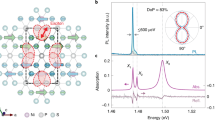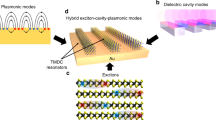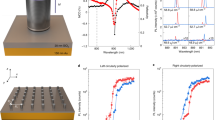Abstract
Controlling quantum materials with light is of fundamental and technological importance. By utilizing the strong coupling of light and matter in optical cavities1,2,3, recent studies were able to modify some of their most defining features4,5,6. Here we study the magneto-optical properties of a van der Waals magnet that supports strong coupling of photons and excitons even in the absence of external cavity mirrors. In this material—the layered magnetic semiconductor CrSBr—emergent light–matter hybrids called polaritons are shown to substantially increase the spectral bandwidth of correlations between the magnetic, electronic and optical properties, enabling largely tunable optical responses to applied magnetic fields and magnons. Our results highlight the importance of exciton–photon self-hybridization in van der Waals magnets and motivate novel directions for the manipulation of quantum material properties by strong light–matter coupling.
This is a preview of subscription content, access via your institution
Access options
Access Nature and 54 other Nature Portfolio journals
Get Nature+, our best-value online-access subscription
$29.99 / 30 days
cancel any time
Subscribe to this journal
Receive 51 print issues and online access
$199.00 per year
only $3.90 per issue
Buy this article
- Purchase on Springer Link
- Instant access to full article PDF
Prices may be subject to local taxes which are calculated during checkout




Similar content being viewed by others
Data availability
The main datasets generated and analysed in this study are available at https://doi.org/10.5281/zenodo.7940672 (ref. 30). Supplementary data will be provided by the corresponding authors upon request. Source data are provided with this paper.
References
Garcia-Vidal, F. J., Ciuti, C. & Ebbesen, T. W. Manipulating matter by strong coupling to vacuum fields. Science 373, eabd0336 (2021).
Schlawin, F., Kennes, D. M. & Sentef, M. A. Cavity quantum materials. Appl. Phys. Rev. 9, 011312 (2022).
Bloch, J., Cavalleri, A., Galitski, V., Hafezi, M. & Rubio, A. Strongly correlated electron–photon systems. Nature 606, 41–48 (2022).
Sentef, M. A., Ruggenthaler, M. & Rubio, A. Cavity quantum-electrodynamical polaritonically enhanced electron-phonon coupling and its influence on superconductivity. Sci. Adv. 4, eaau6969 (2018).
Ashida, Y. et al. Quantum electrodynamic control of matter: cavity-enhanced ferroelectric phase transition. Phys. Rev. X 10, 041027 (2020).
Appugliese, F. et al. Breakdown of topological protection by cavity vacuum fields in the integer quantum hall effect. Science 375, 1030–1034 (2022).
Seyler, K. L. et al. Ligand-field helical luminescence in a 2D ferromagnetic insulator. Nat. Phys. 14, 277–281 (2018).
Zhang, Z. et al. Direct photoluminescence probing of ferromagnetism in monolayer two-dimensional CrBr3. Nano Lett. 19, 3138–3142 (2019).
Kang, S. et al. Coherent many-body exciton in van der Waals antiferromagnet NiPS3. Nature 583, 785–789 (2020).
Wilson, N. P. et al. Interlayer electronic coupling on demand in a 2D magnetic semiconductor. Nat. Mater. 20, 1675–1662 (2021).
Klein, J. et al. The bulk van der Waals layered magnet CrSBr is a quasi-1D quantum material. ACS Nano 17, 5316–5328 (2023).
Huang, B. et al. Layer-dependent ferromagnetism in a van der Waals crystal down to the monolayer limit. Nature 546, 270–273 (2017).
Wu, M., Li, Z., Cao, T. & Louie, S. G. Physical origin of giant excitonic and magneto-optical responses in two-dimensional ferromagnetic insulators. Nat. Commun. 10, 2371 (2019).
Hwangbo, K. et al. Highly anisotropic excitons and multiple phonon bound states in a van der Waals antiferromagnetic insulator. Nat. Nanotechnol. 16, 655–660 (2021).
Dirnberger, F. et al. Spin-correlated exciton–polaritons in a van der Waals magnet. Nat. Nanotechnol. 17, 1060–1064 (2022).
Canales, A., Baranov, D. G., Antosiewicz, T. J. & Shegai, T. Abundance of cavity-free polaritonic states in resonant materials and nanostructures. J. Chem. Phys. 154, 024701 (2021).
Klingshirn, C. F. Semiconductor Optics (Springer, 2012).
Munkhbat, B. et al. Self-hybridized exciton-polaritons in multilayers of transition metal dichalcogenides for efficient light absorption. ACS Photon. 6, 139–147 (2018).
Fieramosca, A. et al. Tunable out-of-plane excitons in 2D single-crystal perovskites. ACS Photon. 5, 4179–4185 (2018).
Dang, N. H. M. et al. Tailoring dispersion of room-temperature exciton-polaritons with perovskite-based subwavelength metasurfaces. Nano Lett. 20, 2113–2119 (2020).
Klein, J. et al. Sensing the local magnetic environment through optically active defects in a layered magnetic semiconductor. ACS Nano 17, 288–299 (2023).
Lim, H.-T., Togan, E., Kroner, M., Miguel-Sanchez, J. & Imamoğlu, A. Electrically tunable artificial gauge potential for polaritons. Nat. Commun. 8, 14540 (2017).
Bajoni, D. et al. Polariton light-emitting diode in a gaas-based microcavity. Phys. Rev. B 77, 113303 (2008).
Bae, Y. J. et al. Exciton-coupled coherent magnons in a 2D semiconductor. Nature 609, 282–286 (2022).
Diederich, G. M. et al. Tunable interaction between excitons and hybridized magnons in a layered semiconductor. Nat. Nanotechnol. 18, 23–28 (2023).
Cham, T. M. J. et al. Anisotropic gigahertz antiferromagnetic resonances of the easy-axis van der Waals antiferromagnet CrSBr. Nano Lett. 22, 6716–6723 (2022).
López-Paz, S. A. et al. Dynamic magnetic crossover at the origin of the hidden-order in van der Waals antiferromagnet CrSBr. Nat. Commun. 13, 4745 (2022).
Liu, W. et al. A three-stage magnetic phase transition revealed in ultrahigh-quality van der Waals bulk magnet CrSBr. ACS Nano 16, 15917–15926 (2022).
O’Donnell, K. & Chen, X. Temperature dependence of semiconductor band gaps. Appl. Phys. Lett. 58, 2924–2926 (1991).
Dirnberger, F. Magneto-optics in a van der Waals magnet tuned by self-hybridized polaritons. Zenodo https://doi.org/10.5281/zenodo.7940672 (2023).
Acknowledgements
Work at the City College of New York was supported by the National Science Foundation (DMR-2130544), the National Science Foundation Centers of Research Excellence in Science and Technology - Center for Interface Design and Engineered Assembly of Low-dimensional Systems (CREST IDEALS) centre (V.M.M.), the Defense Advanced Research Projects Agency (DARPA) Nascent Light–Matter Interaction program (R.B.) and the German Research Foundation (451072703; to F.D.). J.Q. and A.A. were supported by the Office of Naval Research, the Air Force Office of Scientific Research and the Simons Foundation. A.A. and V.M.M. acknowledge funding from the US Air Force Office of Scientific Research Multidisciplinary University Research Initiatives (FA9550-22-1-0317). We acknowledge the use of the City University of New York Advanced Science Research Center Nanofabrication Facility for the device fabrication. Z.S. was supported by the European Research Council Czech (ERC-CZ) programme (LL2101) from the Ministry of Education, Youth and Sports. K.M. was supported by the specific university research A2 FCHT 2023 077. The transient magneto-optical measurement at the University of Washington is mainly supported by the Department of Energy, Basic Energy Sciences, Materials Sciences and Engineering Division (DE-SC0012509). This research was supported by an appointment to the Intelligence Community Postdoctoral Research Fellowship Program at the University of Washington, administered by Oak Ridge Institute for Science and Education through an interagency agreement between the US Department of Energy and the Office of the Director of National Intelligence. M.F. and J.K. acknowledge support from the Alexander von Humboldt Foundation. A.K. and F.J.G.-V. acknowledge support from the Spanish Ministry for Science and Innovation–Agencia Estatal de Investigación (PID2021-125894NB-I00 and CEX2018-000805-M through the María de Maeztu program for Units of Excellence in R&D), the Autonomous Community of Madrid, the Spanish Government and the European Union (Mecanismo de Recuperación y Resiliencia (MRR) Advanced Materials MAD2D-CM).
Author information
Authors and Affiliations
Contributions
F.D. and V.M.M. conceived the experimental idea and interpreted the results together with all of the authors. F.D., J.Q., R.B. and G.M.D. performed the experiments and conducted the data analysis. K.M. and Z.S. synthesized the CrSBr crystals. M.F., A.K. and F.J.G.-V. developed the analytic and numeric theories. F.D. wrote the manuscript with input from all authors and supervised the project with A.A. and V.M.M.
Corresponding authors
Ethics declarations
Competing interests
The authors declare no competing interests.
Peer review
Peer review information
Nature thanks Jae-Ung Lee and the other, anonymous, reviewer(s) for their contribution to the peer review of this work.
Additional information
Publisher’s note Springer Nature remains neutral with regard to jurisdictional claims in published maps and institutional affiliations.
Supplementary information
Rights and permissions
Springer Nature or its licensor (e.g. a society or other partner) holds exclusive rights to this article under a publishing agreement with the author(s) or other rightsholder(s); author self-archiving of the accepted manuscript version of this article is solely governed by the terms of such publishing agreement and applicable law.
About this article
Cite this article
Dirnberger, F., Quan, J., Bushati, R. et al. Magneto-optics in a van der Waals magnet tuned by self-hybridized polaritons. Nature 620, 533–537 (2023). https://doi.org/10.1038/s41586-023-06275-2
Received:
Accepted:
Published:
Issue Date:
DOI: https://doi.org/10.1038/s41586-023-06275-2
This article is cited by
-
Hyperbolic exciton polaritons in a van der Waals magnet
Nature Communications (2023)
Comments
By submitting a comment you agree to abide by our Terms and Community Guidelines. If you find something abusive or that does not comply with our terms or guidelines please flag it as inappropriate.



